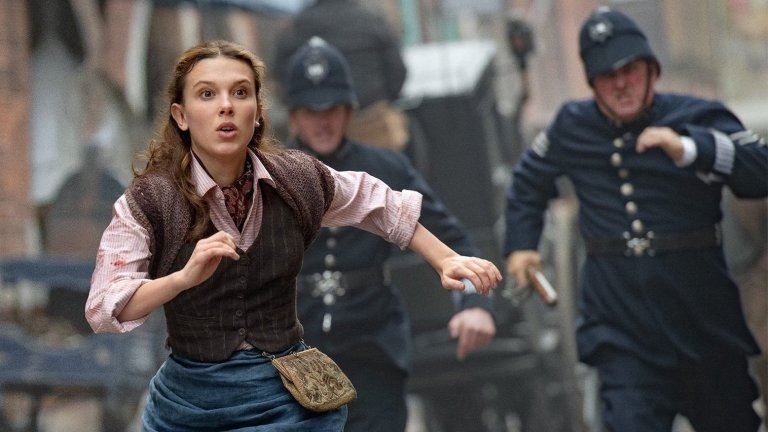The Real History of Enola Holmes 2 and the Matchgirls’ Strike of 1888
Here is the real story behind the inspiration for Netflix’s second girl detective movie starring Millie Bobby Brown, Enola Holmes 2.

This piece contains spoilers for Enola Holmes 2.
The first official case for young Enola Holmes (Millie Bobby Brown) starts with a missing girl: factory worker named Sarah Chapman (Hannah Dodd). But as Enola tugs at all the loose threads, she discovers mounting evidence—a missing page from the factory books, a suspicious surge of typhus, a scandalous romance—that draws the attention of the factory’s owners, Scotland Yard, and even her brother Sherlock (Henry Cavill). It all culminates in Sarah, her sister Bessie (Serrana Su-Ling Bliss), and the other factory girls going on strike—a real-life event which grounded the movie’s events in a sense of historical context.
The Matchgirls’ strike of 1888 changed the working conditions at the Bryant & May match factory, but it was not the first of its kind. The matchgirls went on strike several times between the 1870s to 1880s, always in an attempt to address the same recurring issues: low wages, the fine structures that would strip matchgirls of their pay for tiny offenses (as seen in the film with the cruel foreman docking pay for petty reasons), and potential taxes on the matches. All throughout this time, factory workers would report of toothaches, which usually worsened into abscesses or fistulas—a condition known as “phossy jaw,” nicknamed for the white phosphorus that the matches were dipped into, which had replaced the formerly useful red phosphorus at a much cheaper price.
Enola Holmes 2 emphasizes the social dimension of the switch from red to white phosphorus, with the upper-class owners of the fictional Lyon match factory using the high-society Annual Ball to celebrate their supposed new innovation. Meanwhile at the factory, the girls keep getting sent home for “typhus.” This appears to be a red herring written in for the film’s mystery; in real life, the Bryant & May factory owners were well aware of phossy jaw and considered it as yet another occupational hazard to be managed.
Though initially introduced in the film as an anonymous redhead, Sarah Chapman was a real person and one of the key figures in the Matchgirls’ strike. Enola Holmes 2 adds plenty of fictional details to amp up the mystery of her disappearance, from Sarah’s second job as a dancing girl at the Paragon Theatre to her romance with William Lyon (Gabriel Tierney), son of factory owner Henry Lyon (David Westhead). Despite the fictionalization, the filmmakers did do their research; “Where Did You Get That Hat?,” the vaudeville song that the dancing girls perform when Enola attends a local nightclub, was written in 1888. But in real life, Sarah was among the factory workers who met with socialist organizations like the Fabian Society to raise awareness, and who connected with writers who could get the word out.
A figure from the strike who does not factor into Enola Holmes 2 is Annie Besant, a women’s rights activist, socialist, philanthropist, and much more. A prolific writer, she publicized the dire conditions in an article in The Link while also helping Chapman establish a strike committee and gain support in Parliament. The response from Bryant & May management was to have the matchgirls sign a statement refuting the article. When they refused to do so, it led to the firing of one girl, which in turn spurred on the strike on July 5, 1888.
In a sense, Enola takes on Besant’s role in the story, less as a replacement and more of a reinterpretation: Rather than try to raise awareness in the public sphere, she sleuths her way through the factory undercover and then follows subsequent clues around London. With the film introducing a number of new characters, it would probably have been too much to have a very vocal reformer for Enola to either clash against or team up with. And while it would have been great to see Enola find a potential older female mentor, she has plenty of those in returning characters like her mother Eudoria (Helena Bonham Carter) and teahouse owner/jujutsu instructor Edith (Susan Wokoma), as well as in intriguing new character Mira Troy (Sharon Duncan-Brewster).
Like a faulty match, the workers’ prior strikes were attempts to spark change that didn’t catch on until the 1888 strike. A combination of support from Besant and MPs, as well as the matchgirls’ own organizing committee, aided them in getting their demands met: eradicating the fines system; the ability to bring issues straight to management and cut out the foreman; and the matchgirls being able to take meals in rooms where they would not be exposed to white phosphorus. Chapman and others subsequently established the Union of Women Match Makers, the largest female union in the country.
While Enola Holmes 2 ends on the triumphant visual of the matchgirls marching toward Parliament, the 1888 strike didn’t definitively eliminate the use of white phosphorus. That took another 20 years; Bryant & May didn’t stop using white phosphorus until 1901, and it took the 1906 Berne Convention prohibiting the use of white phosphorus to compel the House of Commons to finally prohibit its usage in the UK after 1910.
If the Enola Holmes films continue to go off-book but stay on historical timeline, they’ll have plenty of material; it turns out that 1888 was a busy year for London, with Jack the Ripper committing his murders in the East End. You know that’s a case Enola (and Sherlock) would not be able to resist investigating.
Enola Holmes 2 is streaming now on Netflix.
